|


The Experiences
Experience The Experience Of Being
Buried Alive (June 14/8 PM: Los
Angeles, June 30/8 PM: Vancouver, July 8/7 PM: San Francisco)
Experience
The Experience Of An Illegal Space Race
(June 25/ 2 PM: Los Angeles)
Experience
The Experience Of Growing Money
(July 14/ 8 PM: San Francisco)
Experience
The Experience Of A Magnetism Party
(June 18/8 PM, Los Angeles)
Experience The Experience Of Catapulting Wireless
Devices (Workshop: July 9/6 PM; Event: July 16/2 PM, San Francisco)
Experience The Experience Of A Brick Of Coke
(June 21/8 PM: Los Angeles)
Experience The Experience Of 1 Baud
(Workshop: July 20/6 PM; Event: July 22/5 PM: San Francisco) |
|
|
Experience The Experience Of An Illegal Space Race
|
LA is big. Big enough for an "illegal space race". We will place the planets true to scale (sun, 4 meters in diameter, Pluto, one centimeter in diameter, about 11 miles away) throughout the LA cityscape. Then we will conduct a car race. The team that makes it through 'LA space' fastest wins the interplanetary trophy. In conclusion, of course, the speeds of the cars will be calculated, for example, how much faster than light they were. Planetary scientists will be on hand as guests to comment on the events.
Los Angeles (Machine Project): June 25, 2 PM.
|
Disposition And Cleanup
June 27. Afternoon.
We clean the sun with a mop, we put it into a cardbox and ship it to Vienna.
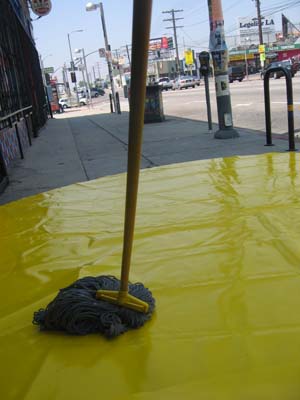
The outer solar system is completely lost.
Evelyn manages to retrieve the inner planets, though.
Mercury, Venus, Earth and Mars stay in LA. The property passes on to Caryn Coleman. You can only observe them on appointment.
[posted by johannes at
12:52 AM]
A Cannonball-Like Swing-By Race Through LA Space
June 25. Afternoon.
3:16 PM -- Launch!
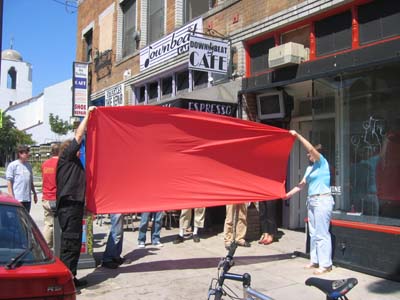

A group of wacky racers discovers Mercury.
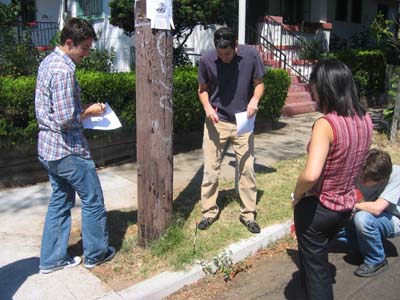
They find Earth.

They visit Halley's Comet.
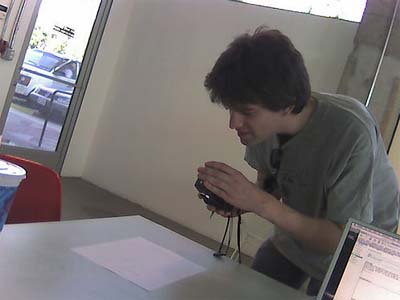
A long time passes. We get some calls for directions at ground control.
But there is silence after 5:30 PM.
We lose hope.
6:49 PM.
One of the contestants returns!
Michael Shaub is officially declared winner of the 'Illegal Space Race'!
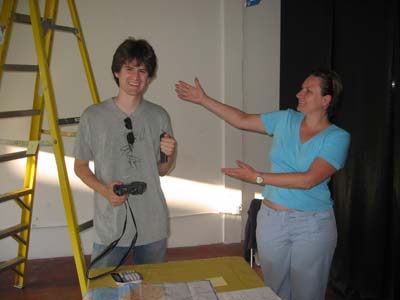

According to the odometer of his car he drove 41.6 miles which took him 3 hours and 33 minutes. Michael drove almost four times faster than the speed of light. We hope he won't get a speeding ticket.
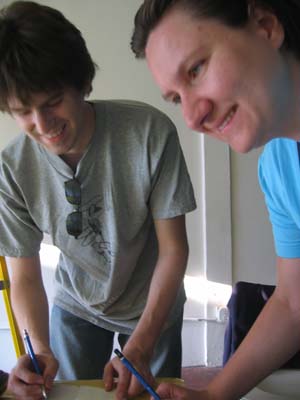
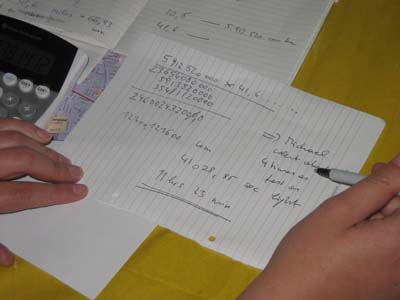
He reports that Jupiter was stolen and so he couldn't take down the Jovian codeword. Some of the gas planets burst and fell apart. He documented the planetary tragedies.
A security officer tried to prevent him from taking pictures of Pluto at the Westwood Federal Building. Quote: "I don't understand what you are doing but you can't do it."
Picture 1: Disintegrated Saturn.
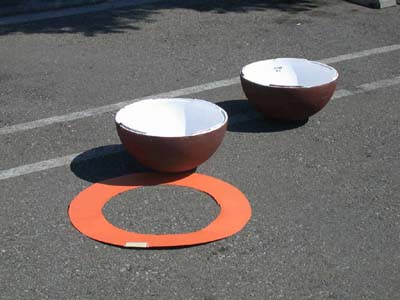
Picture 2: Collapsed Uranus.
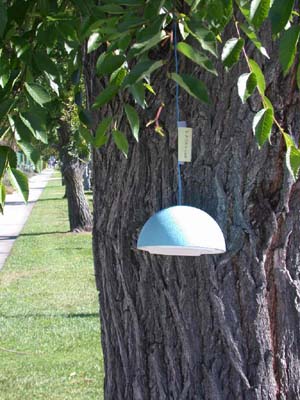
Picture 3: Illegal Space Race turns Illegal Picture Taking Effort At Federal Building.
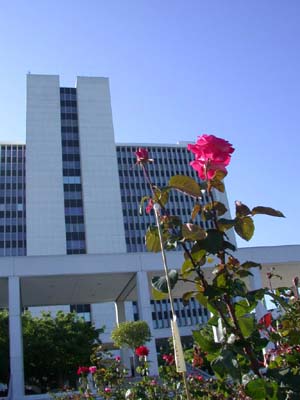
Unfortunately, all the other racers are lost in space.
[posted by johannes at
7:29 PM]
Preparing A Cannonball-Like Swing-By Race Through LA Space
June 25. Morning.
In order to make sure the contestants can't skip planets, we attach small post-it notes with codewords to all planets.
Evelyn and Günther go on a car tour to set up the gas giants and Pluto.
Johannes walks over to Echo Park to place the inner planets.
Caryn and Sean locate Halley's on their desk at Sixspace Gallery.
Locations:
Mercury:
Elsinor St/Mohawk St

Venus:
Glendale Blv/Montrose St

Earth:
Glendale Blv/Echo Park West

Mars:
Glendale Blv/101 underpass

Jupiter:
Carondelet St/ 7th St

Halley's Comet:
Sixspace Gallery, 549 W 23rd St

Saturn:
11th St parking lot between Figueroa and Flower St
(right behind the fence left of the entrance)

Uranus:
6th St/Ogden Drive (La Brea Tarpits)
(hanging from a tree in front of Hancock Park entrance)

Neptune:
Crescent Drive, Beverly Hills City Hall, main entrance
(hanging from tree right next to huge number 5)

Pluto:
Federal Building Westwood
(main entrance, in rose bed)
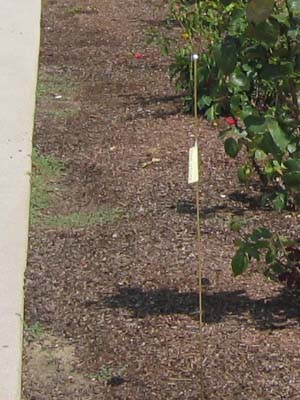
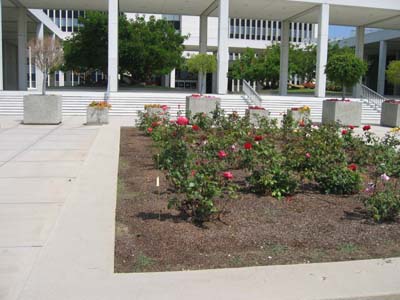
June 15. 2 PM.
Patrick Dondl (Caltech) starts his lecture.
Basic fact stuff about the solar system.

Some of the guests sit on the photosphere of the Sun.
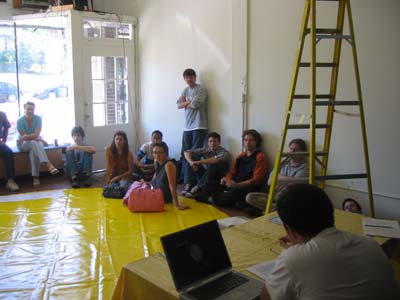
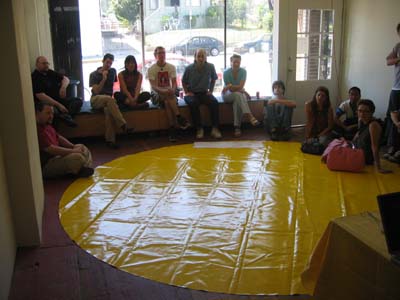
Johannes and his beloved Pluto.

Excellent! A couple of people want to face the infinity of the cosmos!
Johannes and Evelyn give them detailed info about the positions of the different celestial bodies.
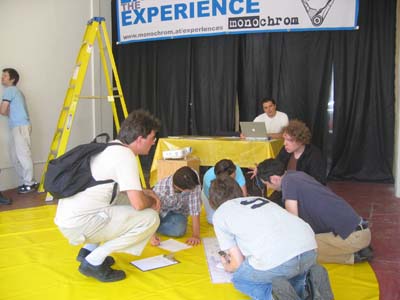
Starting countdown.
[posted by johannes at
6:28 PM]
Calculating interplanetary distances
June 23. Afternoon.
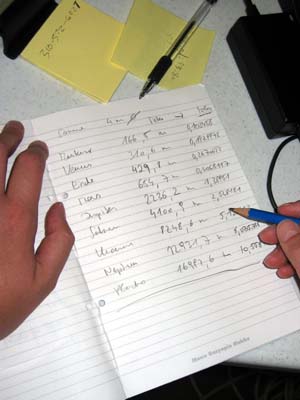
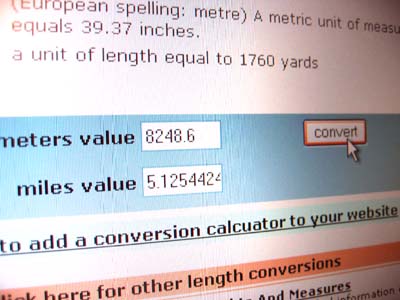

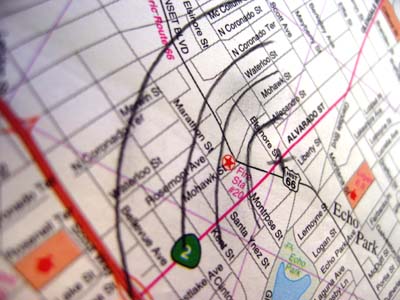
Carl Sagan would be proud of us.
[posted by johannes at
2:26 PM]
Building better worlds
June 23. Midday.
Preparations.
We manufactured the planets back home in Vienna/Austria.
Unpacking planets.
Checking stock.
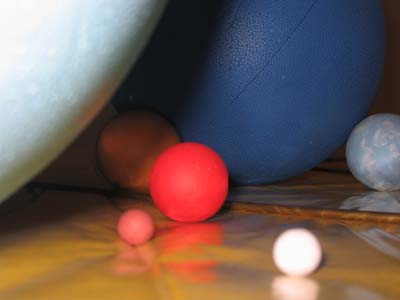
Saturn rings have been damaged during transport.
Creating new Saturn rings.
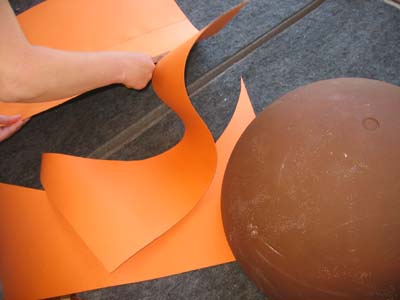
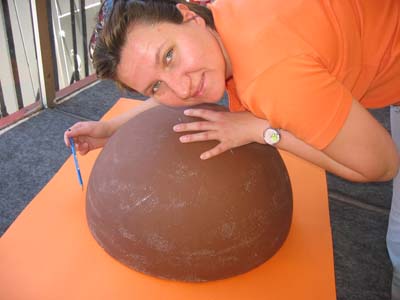
Folded Sun.
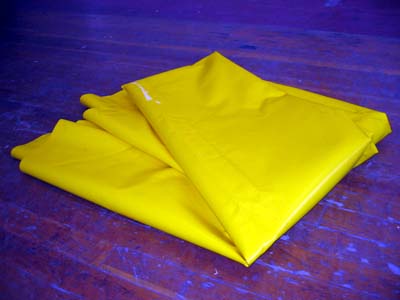
Unfolded Sun. Relative sunspot number: 2 (slipper-sized).
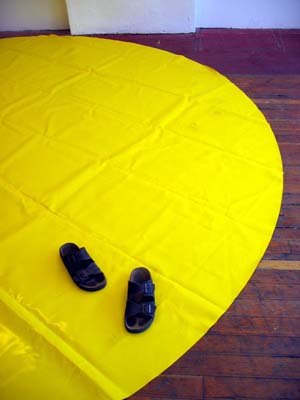
We're on schedule.
[posted by johannes at
1:33 PM]
Solar system facts
Some facts about the solar system we live in
The Solar System consists of the Sun and all the objects that orbit it, including meteors, asteroids, comets, moons, and planets. The Sun In the center of our solar system is a star of spectral class G--which means it is a yellow star--and it contains 99.86% of all the mass in the solar system. It orbits the center of our galaxy at a speed of about 217 km/s, the full cycle takes 226 million years. Its shape is almost perfectly spherical, due to the relatively slow rotation which makes centrifugal forces small compared to the gravitation. The sun does not have a defined boundary, instead, its density falls off exponentially from the center. Usually, one defines the radius of the sun as the radius of the so called photosphere, the radius where the sun becomes opaque to visible light. Nevertheless, several layers of the sun can be clearly distinguished. The core, with a density of about 150 times the mass density of water, is where virtually all the energy in out solar system is produced through the process of nuclear fusion. 4 Protons react to 1 Helium core, 2 electrons and 2 electrom neutrinos at a rate of about 10^38 per second, producing an energy equivalent to 10^17 tons of TNT per second. The rest of the star is heated by that energy. Futher outward is the radiative zone, from about 20% to 70% of the radius, where energy is transported through electromagnetic radiation. Outside of this zone, all the way up to the photosphere, energy is transported by means of thermal convection. The photosphere, at a temperature of about 6000K is the visible surface of the sun. Its density there is about 1% of the denisty of the air on the surface of the earth. Further outside lie the chromosphere, dominating the absorption spectrum of the sun, and the corona, merging smoothly with the solar wind. To obtain an uninterrupted view of the Sun, the European Space Agency and NASA cooperatively launched the Solar and Heliospheric Observatory (SOHO) on December 2, 1995. Elemental abundances in the photosphere are well known from spectroscopic studies, but the composition of the interior of the Sun is much less well known. A solar wind sample return mission, Genesis, was designed to allow astronomers to directly measure the composition of solar material. It returned to Earth in 2004 and is undergoing analysis, but it was damaged by crash-landing when its parachute failed to deploy on reentry to Earth's atmosphere.
The Terrestrial Planets.
Mercury is the closest planet to the Sun, and the second-smallest planet in the Solar System. The temperature on the surface varies from 90K to about 700K, due to the fact that the sunlight is 6.5 times as intense on Mercury than on earth. The planet is composed of about 70% iron and 30% silicate, it does not have an atmosphere. Until 1960 it was belived that the planet was 1 to 1 tidally locked with the sun, i.e. rotating around its own axis once for every sun orbit. Radar observations proved that the ratio is 3:2. The orbit is the second most excentric in the solar system, only beaten by Pluto. The planet was known at least since the time of the Sumerians (about 3000 BC), even though observation is complicated by the fact that it is never seen very far away from the sun. The low orbit also makes approaching Mercury by spacecraft difficult, so that the only mission so far was NASA's Mariner 10 in '74-'75. A second NASA mission, MESSENGER is currenly on the way, supposed to have first contact in 2008, and entering a year long orbit in 2011. Also, Japan and the ESA are currently planning missions to Mercury.
The third brightest object in the sky, after the sun and the moon is the planet Venus, sometimes referred to as the ''Morning Star'' or the ''Evening Star''. Its composition is very similar to the earth's, its atmosphere is extremely dense and consists mostly of carbon dioxide and some nitrogen, which makes for a strong geenhouse effect responsible for surface temperatures up to about 500K. The surface itself consists almost entirely of solidified basaltic lava, with two large highlands, Ishtar Terra, containing the highest mountain on Venus, Maxwell Montes, about 2km higher than the Mount Everest, and Aphrodite Terra. Due to its brightness, Venus has been known ever since before history. The early Greeks thought that the evening and morning appearances of Venus represented two different objects, calling it Hesperus when it appeared in the western evening sky and Phosphorus when it appeared in the eastern morning sky. They eventually came to recognize that both objects were the same planet; Pythagoras is given credit for this realization. In the 4th century BC, Heraclides Ponticus proposed that both Venus and Mercury orbited the Sun rather than Earth. Attempts for Exploration of Venus by spacecraft were started with the Soviet space probe Venera 1, the first sucessful attempt of a fly-by maneuver was the American Mariner 2, the first spacecraft to land on the surface of Venus was Venera 3. Further Soviet Venus lander missions produced the first pictures of Venus taken from its surface. The US space probe Magellan radar-mapped the surface with a resulation of about 100m. The next mission to the planet will be ESA's Venus Express to start in 2006.
Earth, the third planet in the solar system, consists of about 34% iron, 28% oxygen, 17% silicon, and 16% magnesium. The inner core is mostly solid iron, the outer core liquid iron. The next layer, the Earth's mantle is primarily composed of iron and magnesium righ substances. It ranges from solid to plastic. Why is the inner core thought solid, the outer core thought liquid, and the mantle solid/plastic? The melting points of iron-rich substances are higher than pure iron. The core is composed almost entirely of pure iron, while iron rich substances are more common outside the core. So, surface iron-substances are solid, upper mantle iron-substances are semi-molten (as it is hot and they are under relatively little pressure), lower mantle iron-substances are solid (as they are under tremendous pressure), outer core pure iron is liquid as it has a very low melting point (despite enormous pressure), and the inner core is solid due to the overwhelming pressure found at the center of the planet. The highest point of the Earth is Mount Everest at 8850m, the lowest point on land is the Dead Sea at -417m, and the lowest point overall is the Mariana Trench in the Pacific Ocean at -1210,924m. The atmosphere of the Earth consists mostly of nitrogen, oxygen and some argon. The Earth is the only known planet where life exists, it is also the only planet known to have a surface of liquid water. It takes Earth 23 hours, 56 minutes and 4.091 seconds (1 sidereal day) to rotate around the axis connecting the north pole and the south pole, and 365.2564 mean solar days to orbit the Sun. The only natural satellite of the Earth is the Moon, orbiting every 27 1/3 days.
Mars is the fourth planet from the Sun in the solar system. It is named after Mars, the god of war in Roman mythology because of its red color as viewed in the night sky. Mars has always fascinated people. Its red, fiery appearance is caused by Iron Oxide (rust) on its surface. Mars has only a quarter the surface area of the Earth and only one-tenth the mass (though its surface area is approximately equal to that of the Earth's dry land because Mars lacks oceans). The solar day on Mars is almost the same length as it is on earth: 24 hours, 39 minutes, and 35.244 seconds. Mars' atmosphere is thin: the air pressure on the surface is only 750 pascals, about 0.75% of the average on Earth. However, the scale height of the atmosphere is about 11km, somewhat higher than Earth's 6km. The atmosphere on Mars is 95% carbon dioxide, 3% nitrogen, 1.6% argon, and traces of oxygen and water. In 2003, methane was also discovered in the atmosphere by Earth-based telescopes, and possibly confirmed in March 2004 by the Mars Express Orbiter, present measurements state a average methane concetration of about 10 ppb. The presence of methane on Mars is very intriguing, since as an unstable gas. It indicates that there must be (or have been within the last few hundred years) a source of the gas on the planet. Volcanic activity, comet impacts and the existence of life in the form of microorganisms such as methanogens are among possible but as yet unproven sources. The methane appears in patches, which suggests that it is being rapidly broken down (and so is presumably also continually being released to the atmosphere) before it has time to become uniformly distributed in the atmosphere. Plans are now being made to look for other `companion' gases that may suggest which sources are most likely; in the Earth's oceans biological methane production tends to be accompanied by ethane, while volcanic methane is accompanied by sulfur dioxide. Apart from methane release and breakdown, other aspects of the atmosphere are also dynamic, with water vapor moving from one pole to the other with the change between summer and winter, giving rise to Earth-like frost and large cirrus clouds of water-ice that were photographed by the Opportunity rover in 2004. Amongst the findings from the Opportunity rover is the presence of hematite on Mars in the form of small spheres on the Meridiani Planum. The spheres are only a few millimeters in diameter and are believed to have formed as rock deposits under watery conditions billions of years ago. Other minerals have also been found containing forms of sulfur, iron or bromine such as jarosite. This and other evidence led a group of 50 scientists to conclude in the December 9, 2004 edition of the journal Science that ``Liquid water was once intermittently present at the Martian surface at Meridiani, and at times it saturated the subsurface. Because liquid water is a key prerequisite for life, we infer conditions at Meridiani may have been habitable for some period of time in Martian history''. The dichotomy of Martian topography is striking: northern plains flattened by lava flows contrast with the southern highlands, pitted and cratered by ancient impacts. The surface of Mars as seen from Earth is consequently divided into two kinds of areas, with differing albedo. The paler plains covered with dust and sand rich in reddish iron oxides were once thought of as Martian `continents' and given names like Arabia Terra or Amazonis Planitia. The dark features were thought to be seas, hence their names Mare Erythraeum, Mare Sirenum and Aurorae Sinus. The largest dark feature seen from Earth is Syrtis Major. Mars has polar ice caps that contain frozen water and carbon dioxide that change with the Martian seasons-the carbon dioxide ice sublimates in summer, uncovering a surface of layered rocks, and forms again in winter. An extinct shield volcano, Olympus Mons, is at 27km the highest mountain in the solar system. It is in a vast upland region called Tharsis, containing several large volcanos. See list of mountains on Mars. Mars also has the solar system's largest canyon system, Valles Marineris or the Mariner Valley, which is 4000km long and 7km deep. Mars is also scarred by a number of impact craters. The largest of these is the Hellas impact basin, covered with light red sand. Both of Mars's moons, Phobos and Deimos are tidally locked with Mars, always pointing the same face towards it. Since Phobos orbits around Mars faster than the planet itself rotates, tidal forces are slowly but steadily decreasing its orbital radius. At some point in the future Phobos will be broken up by gravitational forces. Deimos, on the other hand, is far enough away that its orbit is being slowly boosted instead. Dozens of spacecraft, including orbiters, landers, and rovers, have been sent to Mars by the Soviet Union, the United States, Europe, and Japan to study the planet's surface, climate, and geography. Roughly two-thirds of all spacecraft destined for Mars have failed in one manner or another before completing or even beginning their missions. The most successful ones so far include NASA's twin Mars Exploration Rovers named Spirit (MER-A) and Opportunity (MER-B).
On towards the Gas Giants.
Jupiter, usually the fourth brightest object in the sky, is the fifth planet from the Sun and by far the largest within our solar system; some have described the solar system as consisting of the Sun, Jupiter, and assorted debris. It and the other gas giants Saturn, Uranus, and Neptune are sometimes referred to as ``Jovian planets.'' Jupiter is 2.5 times more massive than all the other planets combined, so massive that its barycenter with the Sun actually lies above the Sun's surface (1.068 solar radii from the Sun's center). It is 318 times more massive than Earth, with a diameter 11 times that of Earth, and with a volume 1300 times that of Earth. As impressive as it is, extrasolar planets have been discovered with much greater masses. Jupiter also has the fastest rotation rate of any planet within the solar system, resulting in a flattening easily seen through a telescope. Its best known feature is probably the Great Red Spot, a storm larger than Earth. The planet is perpetually covered with a layer of clouds. Jupiter has been known since ancient times. Galileo Galilei's discovery, in 1610, of Jupiter's four large moons Io, Europa, Ganymede and Callisto (now known as the Galilean moons) was the first discovery of a celestial motion not apparently centered on the Earth. It was a major point in favor of Copernicus' heliocentric theory of the motions of the planets; Galileo's outspoken support of the Copernican theory got him in trouble with the Inquisition. Jupiter is composed of a relatively small rocky core, surrounded by metallic hydrogen, surrounded by liquid hydrogen, which is surrounded by gaseous hydrogen. There is no clear boundary or surface between these different phases of hydrogen; the conditions blend smoothly from gas to liquid as one descends. The atmosphere is about 75%/24% by mass Hydrogen/Helium, with about 1% other substances. Jupiter has at least 63 moons. The orbits of Io, Europa, and Ganymede, the largest moon in the solar system, form a pattern known as a Laplace resonance; for every four orbits that Io makes around Jupiter, Europa makes exactly two orbits and Ganymede makes exactly one. A number of probes have visited Jupiter: Pioneer, Voyager, Ulysses and Cassini being flyby missions, and Galileo Jupiter orbiter in 1995, orbiting the planet for 7 years. An atmospheric probe was released from the spacecraft in July, 1995. The probe entered the planet's atmosphere in December 7, 1995. It parachuted through 150km of the atmosphere, collecting data for 58 minutes, before being crushed by the extreme pressure to which it was subjected. NASA is planning a mission to study Jupiter in detail from a polar orbit. Named Juno, the spacecraft is planned to launch by 2010.
Saturn is the sixth planet from the Sun. It is a gas giant, the second-largest planet in the solar system after Jupiter. It has large rings made mainly out of ice and space debris. Saturn's shape is visibly flattened at the poles and bulging at the equator; its equatorial and polar diameters vary by almost 10%. This is the result of its rapid rotation and fluid state. Saturn's interior is similar to Jupiter's, having a rocky core at the center, a liquid metallic hydrogen layer above that, and a molecular hydrogen layer above that. Saturn is probably best known for its planetary rings, which make it one of the most visually remarkable objects in the solar system. The rings were first observed by Galileo Galilei in 1610 with his telescope, but he clearly did not know what to make of them. He wrote to the Grand Duke of Tuscany that ``Saturn is not alone but is composed of three, which almost touch one another and never move nor change with respect to one another. They are arranged in a line parallel to the zodiac, and the middle one [Saturn itself] is about three times the size of the lateral ones [the edges of the rings].'' He also described Saturn as having ``ears.'' The riddle of the rings was not solved until 1655 by Christiaan Huygens, using a telescope much more powerful than the ones available to Galileo in his time. The rings can be viewed using a quite modest modern telescope or with a good pair of binoculars. They extend from 6630km to 120700km above Saturn's equator, and are composed of silica rock, iron oxide, and ice particles ranging in size from specks of dust to the size of a small automobile. While the largest gaps in the rings, such as the Cassini division and Encke division, could be seen from Earth, the Voyagers discovered the rings to have an intricate structure of thousands of thin gaps and ringlets. This structure is thought to arise from the gravitational pull of Saturn's many moons in several different ways. Saturns is known to have at least 48 moons, including Phoebe, Pan and Atlas. The probes the have visited Saturn are the Pioneer 11 and Voyager 1 and 2 as flybys, as well as the Cassini orbiter. Pictures of Saturn have been taken in those missions as well as by the Hubble Space Telescope.
The third largest Planet by diameter, Uranus, is the seventh planet from the Sun. It was the first planet not known in ancient times to be discovered. It is also the only planet in the solar system named after a Greek god. Uranus is composed primarily of rock and various ices, with only about 15% hydrogen and a little helium (in contrast to Jupiter and Saturn which are mostly hydrogen). Uranus (like Neptune) is in many ways similar to the cores of Jupiter and Saturn minus the massive liquid metallic hydrogen envelope. It appears that Uranus does not have a rocky core like Jupiter and Saturn but rather that its material is more or less uniformly distributed. Uranus' cyan color is due to the absorption of red light by atmospheric methane. One of the most distinctive features of Uranus is its axial tilt of almost ninety degrees. Consequently, for part of its orbit one pole faces the Sun continually whilst the other pole faces away. At the other side of Uranus' orbit the orientation of the poles towards the Sun is reversed. Between these two extremes of its orbit the Sun rises and sets around the equator normally. Although Uranus had been observed on many previous occasions it was always dismissed as simply another star. The earliest recorded sighting was in 1690 when John Flamsteed catalogued it as 34 Tauri. Flamsteed observed Uranus twice again, in 1712 and 1715. Bradley observed it in 1748, 1750 and 1753; Mayer in 1756. Lemonnier observed it four times in 1750, twice in 1768, six times in 1769, and one last time in 1771. He was a victim of his own disorderliness: one of his observations was found consigned on a paper bag used to store hair powder! Sir William Herschel discovered the planet on March 13, 1781, but reported it on April 26, 1781 as a ``comet'': Account of a Comet, By Mr. Herschel, F. R. S.; Communicated by Dr. Watson, Jun. of Bath, F. R. S., Philosophical Transactions of the Royal Society of London, Volume 71, pp.492-501. Uranus has 27 known moons. The five main satellites are Miranda, Ariel, Umbriel, Titania and Oberon. NASA's Voyager 2 is the only spacecraft to have visited the planet. Launched in 1977, Voyager made its closest approach to Uranus on January 24, 1986 before continuing on its journey to Neptune.
Neptune is the eighth planet from the sun, and the outermost gas giant in our solar system. It is fourth largest by diameter and third largest by mass but it is the smallest of the gas giants. Orbiting so far from the sun, Neptune receives very little heat. Its surface temperature is -218 degrees C (55K). However, the planet seems to have an internal source of heat. It is thought that this may be leftover heat generated by infalling matter during the planet's birth, now slowly radiating away into space. Neptune's atmosphere has the highest wind speeds in the solar system, up to 2000 km/h, thought to be powered by this flow of internal heat. The internal structure resembles that of Uranus. There is likely to be a core consisting of (molten) rock and metal, surrounded by a mixture of rock, water, ammonia, and methane. The atmosphere, extending perhaps 10 to 20% of the way towards the center, is mostly hydrogen and helium at high altitudes, but has increasing concentrations of methane, ammonia, and water as it approaches and finally blends into the liquid interior. Unique among the gas giants is the presence of high clouds casting shadows on the opaque cloud deck below. Galileo's astronomical drawings show that he had first observed Neptune on December 28, 1612, and again on January 27, 1613; on both occasions Galileo mistook Neptune for a fixed star when it appeared very close (in conjunction) to Jupiter in the night sky. Believing it to be a fixed star, he cannot be credited with its discovery. At the time Galileo first observed Neptune on December 28, 1612, it was stationary in the sky because it had just turned retrograde that very day; because it was stationary in the sky and only beginning the planet's yearly retrograde cycle, its motion was far too slight to be noticed with the naked eye, even with the help that a telescope provided. Had Neptune been moving at its regular/average speed when Galileo first observed it in 1612 and 1613, he would have most likely realised that it was a planet and not a fixed star because of Neptune's relatively rapid normal motion along the ecliptic compared to the extremely slow motion of any random fixed star found in the night sky. In 1821, Alexis Bouvard published astronomical tables of the orbit of Uranus. Subsequent observations revealed substantial deviations from the tables, leading Bouvard to hypothesise some perturbing body. In 1843, John Couch Adams, calculated the orbit of an eighth planet that would account for Uranus' motion. He sent his calculations to Sir George Airy, who asked Adams for a clarification; Adams began to draft a reply but never sent it. In 1846, Urbain Le Verrier, independently of Adams, produced his own calculations but also experienced difficulties in encouraging any enthusiasm in his compatriots. However, in the same year, John Herschel started to champion the mathematical approach and persuaded James Challis to search for the planet. After much procrastination, Challis began his reluctant search in July 1846. However, in the mean time, Le Verrier had convinced Johann Gottfried Galle to search for the planet. Though still a student at the Berlin Observatory, Heinrich d'Arrest suggested that a recently drawn chart of the sky, in the region of Le Verrier's predicted location, could be compared with the current sky to seek the displacement characteristic of a planet, as opposed to a stationary star. Neptune was discovered that very night, September 23, 1846, within 1 degree of where Le Verrier had predicted it to be, and about 10 degrees from Adams' prediction. Challis later realised that he had observed the planet twice in August, failing to identify it owing to his casual approach to the work. In the aftermath of the discovery, there was much nationalistic rivalry between the French and the British over who had priority and who should get credit for the discovery. Eventually an international consensus emerged that both Le Verrier and Adams jointly deserved credit. Neptune is never visible with the naked eye. With the use of a telescope it appears as a blue-green disk, similar in appearance to Uranus; the blue-green colour comes from the methane in its atmosphere. Neptune has 13 known moons. The largest by far is Triton, discovered by William Lassell just 17 days after the discovery of Neptune itself. Like the other gas giants, Neptune has a ring system although much fainter than that of Saturn.
One more, maybe.
Pluto is the ninth planet from the Sun in our solar system. Because Pluto is also the smallest planet in our solar system and has a highly eccentric orbit (which takes it inside the orbit of Neptune) there has been some debate regarding whether Pluto should be classified as a planet. Pluto was discovered by the astronomer Clyde W. Tombaugh at the Lowell Observatory in Arizona on February 18, 1930 when he compared photographic plates taken on January 23 and 29. After the observatory obtained confirming photographs, the news of the discovery were telegraphed to the Harvard College Observatory on March 13, 1930. The planet was later found on photographs dating back to March 19, 1915. Tombaugh was searching for a ``Planet X'' to explain discrepancies in the predicted orbit of Neptune. It is now known now however that these discrepancies were an artifact of the slightly incorrect value then assumed for the mass of Neptune. Pluto is not only much smaller and less massive than every other planet, it is also smaller and less massive than seven moons of other planets. However, Pluto is larger than any minor planet in the main asteroid belt, or any minor planet so far discovered in the trans-Neptunian Kuiper belt. Pluto has an atmosphere when it is close to perihelion; the atmosphere may freeze out as Pluto moves farther from the Sun. It is thought by some that Pluto shares its atmosphere with its moon. Pluto was determined to have an atmosphere from an occultation observation in 1988. When a planet or asteroid occults a star, if it has no atmosphere, the star abruptly disappears. In the case of Pluto, the star dimmed out gradually. From the rate of dimming, the atmosphere was determined to have a pressure of 0.15 pascal. This thin atmosphere is most likely nitrogen and carbon monoxide, in equilibrium with solid nitrogen and carbon monoxide ices on the surface. Pluto has one natural satellite, Charon, first identified in 1978. Pluto and Charon are noteworthy for being the only planet/moon pair in the solar system whose barycenter lies above the planet's surface. Little is known about Pluto because of its great distance from Earth and because no exploratory spacecraft have visited Pluto yet. In 2001, NASA approved preliminary studies for a mission called ''New Horizons'' to Pluto, to be conducted by the Southwest Research Institute. The current schedule has it launching in 2006 and arriving at Pluto in 2015. Originally the Voyager 1 probe was planned to visit Pluto, but due to budget cuts and lack of interest the flyby was cancelled. It was redirected for a close flyby of Saturn's moon Titan.
[posted by johannes at
4:42 PM]
Experience The Experience Of An Illegal Space Race

[posted by johannes at
11:00 AM]
|